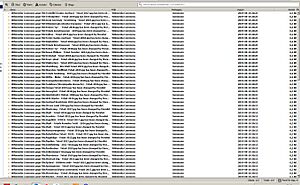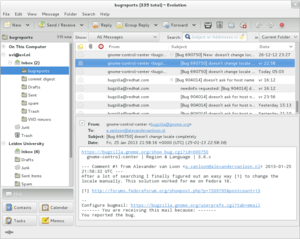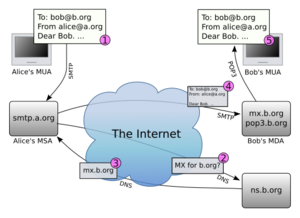Email facts for kids

Electronic mail (often called email or e-mail) is a way to send and get messages using computers and other electronic devices. It was created in the late 1900s as a digital version of regular mail. Think of the "e-" as standing for "electronic." Email is used everywhere today. Having an email address is often needed for many things, like school, shopping, and even just signing up for websites.
Email works across computer networks, especially the Internet. Modern email systems store messages on special computers called servers. These servers accept, send, deliver, and save your messages. You don't need to be online all the time to get an email. You just connect to a mail server or a webmail site to send or receive messages.
At first, email could only send simple text. But then, a system called Multipurpose Internet Mail Extensions (MIME) was added. This allowed emails to carry text in different languages and include attachments like pictures or videos.
Contents
What is Email?
The word electronic mail has been used since 1975. The shorter forms like email or e-mail became popular later.
- email is the most common way to spell it now. Most dictionaries and style guides recommend it.
- e-mail used to be very popular, especially in books and articles, but it's used less often today.
A single electronic message is simply called a message. The parts of an email, like "To," "From," "CC," and "BCC," have been around since 1975.
An Internet email has two main parts: an envelope (which helps it get to the right place) and content. The content itself has a header and a body.
How Email Started
People could send messages between users on the same computer system in the early 1960s. One of the first systems was at MIT in 1965. Many early computers had their own email-like programs, but they usually couldn't talk to each other.
In 1971, the first email was sent over the ARPANET, which was an early version of the Internet. This is when the familiar '@' symbol was first used in email addresses to separate the user's name from the system's name.
Later, big companies like IBM and CompuServe created their own email systems. In 1983, the Simple Mail Transfer Protocol (SMTP) was created for ARPANET. This became a key part of how email works today. By 1995, the Internet's email system (using SMTP, POP3, and IMAP) became the standard way to send emails around the world.
How Email Works
Here's how an email typically travels from you (let's call you Alice) to your friend (Bob):
- Your email program (like Outlook or Gmail) formats your message. It then uses a special rule called SMTP to send the message to your local mail server. Let's say your server is smtp.a.org.
- Your server looks at the email address you typed, like bob@b.org. The part before the @ sign is Bob's username. The part after the @ sign, b.org, is the domain name for Bob's email server. Your server then asks the Domain Name System (DNS) to find Bob's mail server.
- The DNS server for b.org tells your server where Bob's mail server is. Let's say it's mx.b.org.
- Your server (smtp.a.org) sends the message to Bob's server (mx.b.org) using SMTP. Bob's server might send the message to other servers before it reaches Bob's final mailbox.
- Finally, Bob's mail server puts the message into Bob's mailbox.
- Bob's email program then gets the message from his mailbox using either Post Office Protocol (POP3) or Internet Message Access Protocol (IMAP).
Sometimes, things can be a bit different:
- You might use a work email system, which could have its own way of sending emails internally.
- You might use a webmail service (like Gmail) instead of an email program on your computer.
- Bob can also check his email in many ways, like logging into a webmail service.
Email Message Parts
An Internet email message has two main parts: the "header" and the "body." These are also called the "content."
The header is like the information on an envelope. It has fields like "From," "To," "Subject," and "Date." This information helps the email get to the right place and tells you who sent it and what it's about. The body is where your actual message is written. It's usually just text, and sometimes it has a signature block at the end. A blank line separates the header from the body.
Message Header
The email header has several fields. Each field has a name, like "From," followed by a colon (:), and then the value. For example, "Subject: Hello!"
Some important header fields include:
- From: This shows the email address of the person who sent the message. It might also show their name.
- Date: This shows the date and time the message was written. Your email program usually fills this in automatically.
- To: This shows the email address(es) of the main person or people the message is for.
- Subject: This is a short summary of what the email is about. You often see "RE:" (for reply) or "FW:" (for forward) in the subject line.
- Cc: (Carbon copy) This is for people who need to know about the email but aren't the main recipients.
- Bcc: (Blind carbon copy) These addresses are hidden from other recipients. No one else can see who is in the Bcc list.
- Message-ID: This is a unique code for each email. It helps prevent sending the same email multiple times and links related messages together.
- In-Reply-To: If your email is a reply, this field links it to the original message.
Message Body
The body of an email is where the actual message is.
Text and HTML
Most modern email programs let you choose between sending messages in plain text or HTML.
- Plain text is just simple text without any special formatting.
- HTML email allows you to use different fonts, colors, bold or italic text, and even include pictures and links directly in the message.
HTML emails can look nicer, but they are larger in size. They can also sometimes be used for bad things like phishing (trying to trick you into giving away personal info) or spreading malware (bad software). Because of these risks, some people prefer to send and receive only plain text emails.
Email Programs and Servers
Email messages are sent between computers using special programs called mail transfer agents (MTAs). These MTAs deliver messages to a mail storage area using programs called mail delivery agents (MDAs). If a message can't be delivered, the MTA usually sends a "bounce message" back to the sender to let them know there was a problem.
You can get your messages from servers using standard rules like POP or IMAP. The programs you use to get, read, and manage your email are called mail user agents (MUAs), or simply "email clients."
Many people today don't run their own email programs on their computer. Instead, they use webmail services like Gmail or Yahoo! Mail. These services let you access your email using a web browser from any computer, anywhere.
Types of Email Servers
There are different ways email is stored and accessed:
Web-based Email
Many email providers offer a web-based email service. This means you can log into your email account using any web browser. The mail usually stays on the server, so you need an Internet connection to read it.
POP3 Email Servers
Post Office Protocol 3 (POP3) is a way for your email program to download messages from the mail server. Once downloaded, messages are often removed from the server. This lets you read your emails even when you're not online.
IMAP Email Servers
The Internet Message Access Protocol (IMAP) lets you manage your mailbox from many different devices. For example, you can check emails on your smartphone and then reply more fully on a larger computer. IMAP usually shows you just the email headers (like sender and subject) first. You then choose which messages to download and read. With IMAP, your mail usually stays in folders on the mail server.
How We Use Email
For Business and Organizations
Email is very important for businesses, governments, and other groups. It's a key part of how people communicate at work. Here are some benefits:
- Easier Communication: Email makes it easy to talk to people who are in different buildings, cities, or even countries. It's much simpler and cheaper than setting up meetings or phone calls.
- Flexible Schedules: With meetings or phone calls, everyone has to be available at the same time. Email lets people work on their own schedule. They can read and reply to messages when it's best for them.
- Lower Cost: Sending an email is much cheaper than sending physical mail or making long-distance phone calls.
- Faster Speed: Email is usually much faster than other ways of sending messages.
- Written Record: Unlike a phone call, email creates a written record of your conversation. This can be helpful if you need to remember what was discussed or prove that something was sent.
Email Marketing
Businesses often use "email marketing" to send special offers or news about new products. This works best when people have agreed to receive these emails (this is called "opt-in"). If emails are sent without permission, they are usually seen as unwanted "email spam".
For Personal Use
On Computers
Many people use their home computers to check personal emails from friends and family.
On Mobile Devices
Email is now used on smartphones and other mobile devices. Mobile apps make it easy to check email when you're away from home. This means you can check your email and write messages throughout the day, no matter where you are. In 2011, there were about 1.4 billion email users worldwide!
Many adults check their email on their smartphones more than they browse the web or check social media. Email is a very popular activity on smartphones.
Less Use by Young People
Around 2010, fewer young people (ages 12-17) were visiting email websites. They often preferred instant messaging, texting, and social media. Some people think email is becoming less "cool" for younger generations, like older technologies such as VCRs.
Email Problems
Attachment Size Limits
Email messages can have attachments, which are extra files like documents or pictures. While there's no technical limit to how big an attachment can be, email programs and servers often set limits, usually around 25MB or less. If you need to share larger files, you usually have to use file hosting services instead.
Too Many Emails
Many people who work with computers get so many emails that it feels like "information overload". With mobile devices, people might even get work emails outside of their working hours. This can cause stress and make people feel less happy with their work. Some worry that dealing with too many emails can even lower how much work people get done.
Spam
Email spam is unwanted bulk email, often advertisements. It's very cheap to send, so a huge amount of email traffic is spam. While laws and anti-spam tools help block most of it, a lot of spam is still sent. Spam can also contain dangerous links or programs.
Malware
Emails are a common way for malware (bad software) to spread. This often happens when malicious programs are attached to messages. People are tricked into opening these files, which can then infect their computer with things like worms or ransomware.
Email Spoofing
Email spoofing is when an email looks like it came from someone you know or trust, but it didn't. Spammers and phishing scams often use spoofing to trick you about where the message really came from. For example, an email might look like an invoice from a big company, but it's actually a fake trying to get your money.
Privacy Worries
Without special security, email privacy can be a concern:
- Email messages are usually not encrypted (scrambled) by default.
- Emails travel through many computers before reaching their destination. This means others could potentially read or change the content.
- Many Internet providers store copies of emails on their servers. These copies might stay there for months, even after you delete them from your inbox.
- Hidden "web bugs" in HTML emails can let the sender know when you open an email and from what location.
There are ways to make email more secure, like using Virtual Private Networks (VPNs) or special encryption programs like GPG. These tools can help keep your messages private. Also, be careful with attached files, as they can sometimes contain trojans or viruses.
Flaming
Flaming happens when someone sends an email (or many emails) with angry or aggressive content. Because email feels less personal than talking face-to-face, people sometimes forget to be polite.
Email Bankruptcy
"Email bankruptcy" is when someone has so many unread emails that they give up trying to read and reply to them all. This often happens because of too much information. Sometimes, people send a message explaining that their inbox is full and they are trying to clear it out.
|
- Anonymous remailer
- Anti-spam techniques
- Bounce message
- Comparison of email clients
- Disposable email address
- E-card
- Electronic mailing list
- Email authentication
- Email encryption
- Email hosting service
- Email storm
- Email tracking
- HTML email
- Information overload
- Internet fax
- List of email subject abbreviations
- Netiquette
- Posting style
- Privacy-enhanced Electronic Mail
- Push email
- RSS
- Telegraphy
- Unicode and email
- Usenet quoting
- Webmail, Comparison of webmail providers
- X-Originating-IP
- X.400
See also
 In Spanish: Correo electrónico para niños
In Spanish: Correo electrónico para niños



